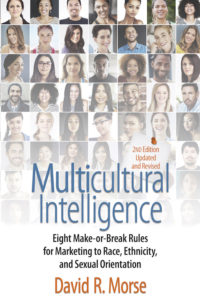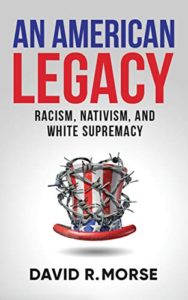This book excerpt from “Divided We Stand: Racism in America from Jamestown to Trump” first appeared on HispanicAd.com.
When Republican presidential nominee Donald Trump descended the elevator, swarmed by media, to announce his candidacy in June 2015, his first shot across the bow – and his campaign was nothing if not pugilistic – was aimed at Mexicans. That day, and nearly every day after, he made immigration the centerpiece of his campaign. But the term Comprehensive Immigration Reform (CIR) did not escape from his lips that June day. Nor did he reach out to U.S. Latinos, as the Republican Party he was running in, claimed to believe in.
Instead, he said this: “When Mexico sends its people, they’re not sending their best. They’re not sending you. They’re not sending you. They’re sending people that have lots of problems, and they’re bringing those problems with us. They’re bringing drugs. They’re bringing crime. They’re rapists. And some, I assume, are good people.” Assuring his audience that his comments were not exclusive to Mexicans, he added, “It’s coming from more than Mexico. It’s coming from all over South and Latin America, and it’s coming probably – probably – from the Middle East. But we don’t know. Because we have no protection and we have no competence, we don’t know what’s happening. And it’s got to stop and it’s got to stop fast.” A month later, he visited the U.S. – Mexico border in Laredo, Texas and boasted to reporters, “There is great danger with the illegals, tremendous danger with illegals,” Trump told reporters, before insisting he had a “great relationship” with Latinos.
It was not the first time, nor will it likely be the last, that Hispanics have been vilified as unwanted intruders. Writing of Mexican Americans, historian Robert R. Treviño notes, “Racism has dogged Mexican immigrants (and native-born) far longer and more virulently than it did any European group that at some given time suffered from American anti-immigrant hysteria and nativism.” It is ironic, given that unlike European immigrants, Hispanics did not cross an ocean to arrive here. Rather, Puerto Rico and a gargantuan swath of Mexico were acquired through conquest, occupation, and exploitation. As a Mexican saying goes, “The border crossed us; we did not cross the border.” In the 20th century, the mass immigration of Mexicans and Puerto Ricans – the two largest Hispanic groups – experienced exploitation and racism, laying the foundation for subsequent patterns of social and economic inequality.
Indeed, the first European settlement in what is now the United States of America was not in Jamestown, as most of us have been taught, but Puerto Rico, in 1505. Eight years later, Juan Ponce de Leon, set sail year for Florida in search of the Fountain of Youth. Florida’s first enduring colony was founded in 1565 at St. Augustine, and it was to be the region’s most significant city for nearly three centuries. By the mid-1500s, the “Tierra Nueva” to the north had been well explored, and its fertile lands, unconverted souls, and unexploited labor sources beckoned the Spanish king’s representatives in Mexico to send settlers. In 1580, an expedition of Franciscans and laymen, mostly miners, left to settle New Mexico. In 1718, a Franciscan, Fray Antonio de Olivares, established a mission, the Alamo, with colonists from the Canary Islands and heavy subsidies from the Spanish crown. Spain established a chain of missions, presidios, and pueblos along the California coast between 1769 and 1817. When the Mexican Republic was established in 1821, it occupied the largest territory in the Western Hemisphere, and was twice the size of the United States.
In May 1846, in a flagrant land grab, Congress declared war on Mexico, and the Americans executed a brutal and bloody campaign. Atrocities committed against Mexicans were the norm. Wrote Captain Ulysses S. Grant, “Some of the volunteers and about all the Texans seem to think it perfectly right to impose on the people of a conquered city to any extent, and even to murder them where the act can be covered by the dark. And how much they seem to enjoy acts of violence too!” General Winfield Scott acknowledged that American soldiers had “committed atrocities to make Heaven weep and every American of Christian morals blush for his country. Murder, robbery, and rape of mothers and daughters in the presence of tied-up males of the families have been common all along the Rio Grande.” When in early 1848, a few months after Scott’s army occupied Mexico City, the two countries signed the Treaty of Guadalupe Hidalgo, and Mexico ceded California, New Mexico, Nevada, and parts of Colorado, Arizona, and Utah, a total of over one million square miles, to the United States for a mere $15 million.
Thousands of Mexicans now found themselves living within the United States, though the treaty did permit them to either remain in the U.S. or move across the new border into Mexico. Most stayed, if only because their homes were north of the Rio Grande, and they became second-class citizens, “foreigners in their own land.” The war had been premised on the doctrine of “manifest destiny” and a “belief in American Anglo-Saxon superiority.” As one Mexican diplomat predicted, “Descendants of the Indians that we are, the North Americans hate us, their spokesmen depreciate us … they clearly manifest that their future expansion begins with the territory that they take from us and pushing aside our citizens who inhabit the land.” Mexicans found themselves powerless as Anglos enacted laws such as the “Greaser Act,” an anti-vagrancy act that defined vagrants as “all persons … of Spanish or Indian blood.” Additionally, the widespread confiscation of Mexican property prompted many owners to sell their land at bargain prices. In the 1850’s, Anglo-Americans, who distinguished themselves as “white folks,” expelled entire communities of Mexicans.
With the arrival of larger numbers of Anglo-Americans, violence committed against Mexicans increased, as many Anglos perceived that Mexicans, by working for lower wages, were stealing their jobs and lowering the standard of living in their neighborhoods. The subordinate racial status of Mexicans, their low wages, and their expertise and skill in performing certain jobs such as mining, led to enmity from the native Anglos, and violence, usually extralegal, followed. According to historians, William D. Carrigan and Clive Webb, between 1848 and 1928, mobs lynched at least 597 Mexicans. Most lynching occurred at the hands of vigilantes who summarily executed victims by mobs, acting “less out of a rational interest in law and order than an irrational prejudice towards racial minorities.” Suspected Mexican criminals were snatched from courtrooms or prison cells and then executed. Such atrocities frequently involved the active collusion of legal officials.
The transportation revolution of the early twentieth century created the demand for Mexican labor and led to the proliferation of automobiles and trains which transported Mexicans to the U.S. border and points beyond. By 1900, an estimated 100,000 Mexican immigrants lived in the United States, up from 42,000 in 1870. The number increased to 1,400,000 by the 1930 census. The entry of the United States into World War I led to an acute labor shortage, and in May 1917, the United States established a program authorizing the INS Commissioner to “control and regulate the admission and return of otherwise inadmissible aliens for temporary admission,” which led to the arrival of about 500,000 Mexican workers before 1921.
Nativism rose, not surprisingly, during the Great Depression. During the 1930s, between 500,000 and one million returned to Mexico, many by deportation, and according to one estimate, over half of those deported were actually U.S. citizens. Although the Immigration Service did not organize or fund the “repatriation” of Mexicans, it encouraged it by generating an atmosphere of fear of deportation. According to historian Mae M. Ngai, “The repatriation of Mexicans was a racial expulsion program exceeded in scale only by the Native American Indian removals of the nineteenth century.” However, World War II brought with it acute labor shortages, particularly agricultural labor, and once again, the United turned to Mexico. In July 1942, the bracero program (named for the Spanish term meaning “manual laborer,” or more literally “one who works using his arms”) was legalized by Congress in 1943, and between 1943 and 1949, an estimated 400,000 braceros came to work under the program.
Mexicans were not the only Spanish-speaking group to migrate to the United States in large numbers after the Second World War; the war’s end coincided with the first large influx of Puerto Ricans, whose population increased from 69,967 individuals in the 1940s to 887,662 in the 1960s. Although the Jones Act of 1917 granted citizenship to Puerto Ricans, thereby eliminating any legal barriers to migration, it was not until the 1950s that Puerto Ricans began to arrive in large numbers, due to high unemployment in Puerto Rico and the introduction of low-cost air travel; the six hour flight from San Juan to New York City cost less than $50. In 1960, 21 percent of Puerto Ricans migrated from the island, and most went to New York City. Life in the metropolis was difficult, and most were severely economically disadvantaged. It was during this time that social scientists began to examine the “Puerto Rican problem” and they focused on Puerto Ricans struggling with English, dropping out of school, working in in low-paying, dead-end jobs, unemployment, and living in dilapidated housing. They were frequently stigmatized as “lazy, ignorant, criminally prone, sexually obsessed, physically unfit, culturally unassimilable, and dark-skinned aliens [even though they were U.S. Citizens].”
The Bracero Program with Mexico was allowed to expire on December 31, 1964. In 1965, passage of the Hart-Cellars Act placed numerical limits on Mexican migration at the same time the Bracero Program was being shut down. However, neither the dependence on Mexican labor nor the need of Mexican nationals to find jobs disappeared. The result was a “massive inflow from Mexico [that] simply reestablished itself under undocumented auspices.” In essence, the Act transformed legal migrant workers into “illegal immigrants.”
The number of Mexican migrants in the country without a green card rose from 88,823 in 1961 to over a million a year by the mid-1970s, and it was at this time that magazine articles began to proliferate with a Mexican “threat narrative,” characterized by two distinct themes. On the one hand, migrants from the south were portrayed as a brown “flood” that would “inundate” American culture and “drown” its society. On the other hand, undocumented migrants were portrayed as “invaders” who “swarmed” across the border in “banzai charges” to overrun “outgunned” Border Patrol Agents who fought vainly to “hold the line” against the “alien invasion.”
Exacerbating the problem was that beginning in the late 1970s, and continuing through the 1980s, there was a mass exodus from Central America to the United States, due to guerrilla wars in Nicaragua and El Salvador, and political strife in Honduras and Guatemala. Additionally, media images of migrants as drug traffickers proliferated in the early and mid-1980s, as U.S. anti-drug trafficking efforts attempted to curtail the success of Colombian smugglers in southern Florida. By 1986, President Ronald Reagan was linking border control to the threat of foreign terrorism, declaring in a televised speech, that “terrorists and subversives are just two days’ driving time from [the border crossing at] Harlingen, Texas.”
California Governor Pete Wilson took immigrant bashing to new levels in his 1994 bid for reelection. His campaign featured televised video footage of illegal immigrants dashing across the border from Mexico into crowded highway traffic, against which a narrator said, “They keep coming. Two million illegal immigrants in California. The federal government won’t stop them at the border, yet requires us to pay billions to take care of them … Enough is enough.” The image of men, women, and children in so-called Banzai runs was broadcast across the nation, and galvanized public attention, reinforcing the image of a nation overrun. In 1996, more than 500 anti-immigrant state-level bills were introduced across the United States, 37 in Arizona alone. By 1999, the Border Patrol had grown to nearly eight thousand agents and inspectors and had a goal of hiring 80 new officers per month, for which it offered a signing bonus.
Under President Barack Obama, deportations reached record levels, rising to an annual average of nearly 400,000 after 2009, totaling 1.5 million during his first term, and ultimately earning him the epithet “Deporter In Chief.” However, in June 2012, Homeland Security Secretary Janet Napolitano announced the Administration’s new policy of Deferred Action for Childhood Arrivals (DACA), which permitted an estimated 1.8 million undocumented immigrants who were brought to the United States as children, and raised here, to obtain temporary relief from removal and, in many cases, employment authorization.
In November 2014, President Obama delivered a televised address that asserted the powers of the Oval Office to reshape the nation’s immigration system and challenged members of the incoming Republican-controlled Congress to reverse his actions, declaring that deporting millions is “not who we are”. The centerpiece of the president’s announcement was a new program for unauthorized immigrants who are the parents of United States citizens, making about four million people eligible for legal status, deferring their deportation and allowing them to work legally — on February 16, 2015, a federal judge in Texas blocked the executive action.
What remains to be seen is whether the vilification of Hispanics is a passing phenomenon, one spurred, as has been the case so often in our history, by immigration levels reaching a crescendo, or if their trajectory will more closely resemble that of African Americans, the recipients of an enduring legacy of disdain and discrimination. Given that in 2017, about three-quarters of Hispanics are of the first or second generation in the United States, complete assimilation has yet to occur.
True acceptance and equality will depend on how willing future generations of white Americans will be to share the spoils as the Hispanic population continues its prodigious growth. Still, there is power in numbers. As the white share of the population pie continues to dwindle, the Hispanic population is expected to reach about 106 million in 2050, nearly double what it is today. Whatever white America may think, the United States is in the throes of a return to its Hispanic roots. The browning of America, largely driven by Latinos, is a demographic reality.



